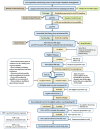Association of Cardiovascular Disease Risk Factors With Estimated Dietary Salt Consumption in Bangladeshi Adults: A Nationally Representative Cross-Sectional Study
- PMID: 39822059
- PMCID: PMC11771797
- DOI: 10.1111/jch.14966
Association of Cardiovascular Disease Risk Factors With Estimated Dietary Salt Consumption in Bangladeshi Adults: A Nationally Representative Cross-Sectional Study
Abstract
This population-based, nationally representative cross-sectional study assessed the daily salt consumption status and its associated cardiovascular disease (CVD) risk factors using weighted data from the STEPwise approach to noncommunicable disease risk factor surveillance conducted in 2018 in Bangladesh. It included a non-institutionalized adults' population of 6189 men and women aged 18-69 years. Their daily salt consumption was estimated using the spot urine sodium concentration following the Tanaka equation and reported according to the standard nomenclature proposed by the World Hypertension League and partner organizations involved in dietary salt reduction. Out of a total of 6189 participants, 2.4% consumed the recommended amount of salt (<5 g/day), 67.8% consumed a high amount of salt (≥5-10 g/day), 27.2% consumed a very high amount of salt (>10-15 g/day), and 2.6% consumed an extremely high amount of salt (>15 g/day). In univariate analysis, a higher than recommended level of salt intake (≥5 g/day) was significantly prevalent among rural residents (high = 78.4%, very-high = 81.6%, extremely-high = 84.9%, p = 0.01), literates (high = 51.6%, very-high = 57.9%, extremely-high = 59.1%, p = 0.02), newly diagnosed hypertension (high = 20.6%, very-high = 23.6%, extremely-high = 24.1%, p = 0.008), and overweight/obese (high = 25.9%, very-high = 33.3%, extremely-high = 29.8%, p = 0.000). Similarly, in ordinal logistic regression analysis, the categories of daily salt consumption showed a significant association with rural residence (OR: 1.300, CI: 1.109-1.524, p = 0.001), literates (OR: 0.777, CI: 0.671-0.900, p = 0.001), newly diagnosed hypertension (OR: 1.204, CI: 1.022-1.419, p = 0.026), and overweight/obesity (OR: 1.353, CI: 1.145-1.598, p = 0.000). The current national pattern of salt consumption in Bangladesh may help reconstruct the salt reduction strategy considering the associated risk factors.
Keywords: Bangladesh; associated factors; cardiovascular disease; risk factors; salt intake; spot urine; standardized nomenclature.
© 2025 The Author(s). The Journal of Clinical Hypertension published by Wiley Periodicals LLC.
Conflict of interest statement
Authors have no conflicts of interest to disclose.
Figures
Similar articles
-
Salt intake across the hypertension care cascade in the Bangladeshi adult population: a nationally representative cross-sectional study.BMJ Open. 2024 Apr 5;14(4):e081913. doi: 10.1136/bmjopen-2023-081913. BMJ Open. 2024. PMID: 38580369 Free PMC article.
-
Dietary salt intake and kidney function in rural Senegalese populations: a cross-sectional study.J Health Popul Nutr. 2024 Jun 26;43(1):97. doi: 10.1186/s41043-024-00542-2. J Health Popul Nutr. 2024. PMID: 38926879 Free PMC article.
-
Knowledge, attitudes, and practices related to salt consumption in Nepal: Findings from the community-based management of non-communicable diseases project in Nepal (COBIN).J Clin Hypertens (Greenwich). 2019 Jun;21(6):739-748. doi: 10.1111/jch.13544. Epub 2019 Apr 26. J Clin Hypertens (Greenwich). 2019. PMID: 31026125 Free PMC article. Clinical Trial.
-
Impact of Salt Intake on the Pathogenesis and Treatment of Hypertension.Adv Exp Med Biol. 2017;956:61-84. doi: 10.1007/5584_2016_147. Adv Exp Med Biol. 2017. PMID: 27757935 Review.
-
Salt consumption by Australian adults: a systematic review and meta-analysis.Med J Aust. 2018 Feb 5;208(2):75-81. doi: 10.5694/mja17.00394. Med J Aust. 2018. PMID: 29385968
References
-
- Noncommunicable diseases. World Health Organization , September 16, 2023, accessed December 3, 2024, https://www.who.int/news‐room/fact‐sheets/detail/noncommunicable‐diseases.
-
- Noncommunicable Diseases Country Profiles 2018 (Geneva: World Health Organization, 2018). Licence: CC BY‐NC‐SA 3.0 IGO.
-
- World Heart Report 2023 , Confronting the World's Number One Killer (Geneva, Switzerland: World Heart Federation, 2023).
MeSH terms
Substances
LinkOut - more resources
Full Text Sources
Medical




